Project details
Skill
Cost
Estimated Time
Vinyl tile flooring is popular among homeowners because it’s durable, affordable, and easy to install. It’s also suitable for several different rooms in your house, including your bathroom, kitchen, or laundry room. Read our guide below for tips on how to cut vinyl tile and lay a vinyl tile floor as part of a do-it-yourself project. We also offer tips on how to prepare for installation by putting down an underlayment.
How To Prepare for Vinyl Tile Floor Installation
Laying a vinyl tile floor is a relatively straightforward project that can significantly improve the look of your space. It requires some physical effort, but the process is manageable for homeowners with basic DIY skills. Gather all the materials and tools you need before you begin.

Tools & Materials Needed for Vinyl Tile Floor Installation
You’ll need the following tools and materials to lay a vinyl tile floor:
- Adhesive, if you’re using glue-down tiles
- Chalk line
- Dust broom
- Finishing nails
- Hammer
- Heat gun
- Leveling compound
- Plywood underlayment
- Rolling pin or J-roller
- Vinyl tiles
- Sanding pad with 100-grit paper
- Shoe molding
- Tape measure
- Undercut saw
- Underlayment nails
- Utility knife
- Vinyl tile cutter
 Heat gun
Heat gun Vinyl tile cutter
Vinyl tile cutter Chalk line
Chalk line Utility knife
Utility knife Tape measure
Tape measure Undercut saw
Undercut saw Dust broom
Dust broom Sanding pad
Sanding pad Hammer
Hammer Rolling pin or J-roller
Rolling pin or J-roller
Tiling a Floor Overview
Plan your layout carefully before you begin your installation project. You can maximize the use of whole tiles and minimize the need for cuts this way. Consider the additional key points below.
- Allow the adhesive to cure for at least 24 hours before you walk on the tiles.
- Make all of your wetsaw cuts in a single day to reduce rental costs.
- Try to use as many whole tiles as possible.
- When you absolutely must cut tiles, try to place them in less noticeable areas, such as under vanities or along walls.
Creating a Stable Base by Installing Underlayment
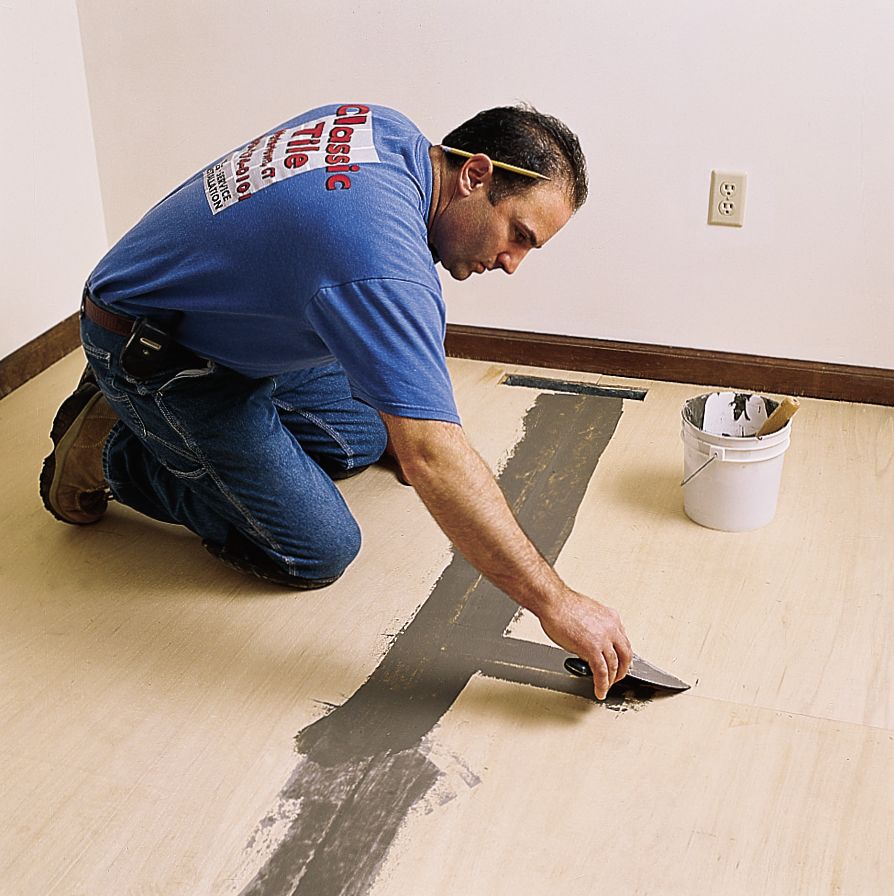
Proper preparation of the subfloor creates a level and smooth surface for your vinyl tiles, and will extend the life of your new floor. Follow the steps below to create a stable base for your new floor:
- Remove any existing shoe molding from around the room’s perimeter.
- Cover the entire floor with 1/4-inch plywood underlayment. Secure it using 1 1/4-inch underlayment nails, and stagger the joints to increase stability.
- Apply a thin layer of leveling compound along the plywood seams using a 6-inch drywall knife. Allow the compound to dry completely, which usually takes about 30 minutes.
- Once the compound is dry, sand the seams using a sanding pad that has 100-grit paper.
- Remove all dust and debris before you proceed with tiling.
Trim the Door Jamb and Casing
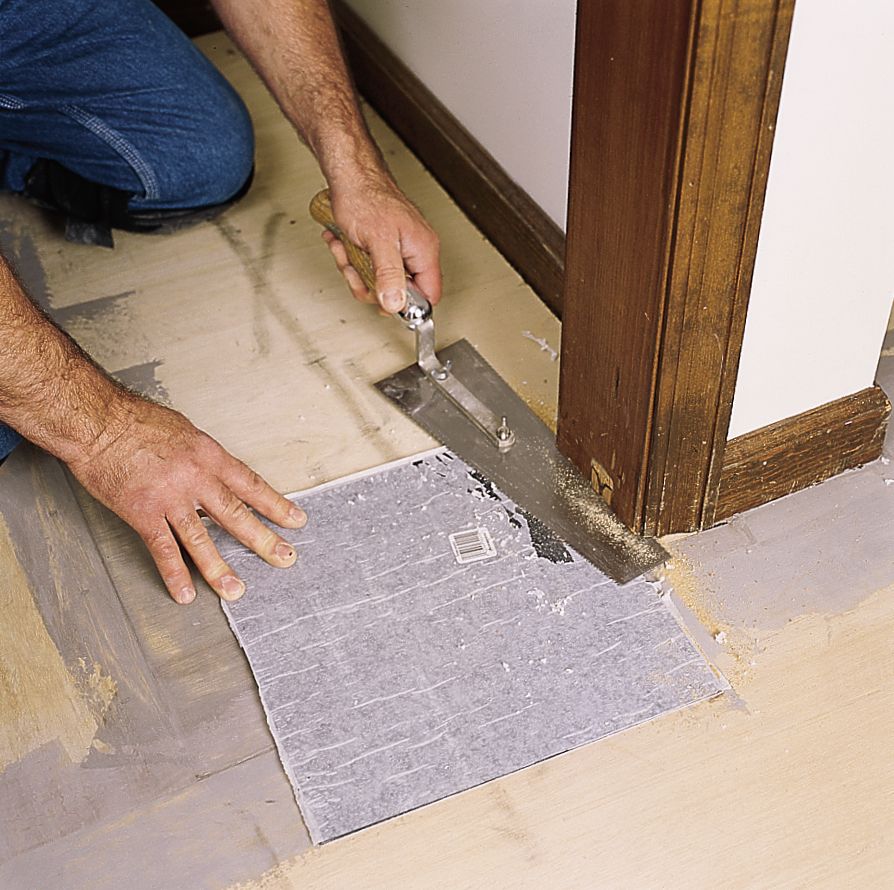
You’ll need to trim the door jambs and casings to achieve a seamless look where the tiles meet door frames. Learn how to do this below.
- Place an upside-down tile in front of the door jamb as a height guide.
- Lay an undercut saw flat on top of the tile and carefully cut through the jamb.
- Repeat this process for the door casing, and slide the tile around to the front.
- Perform these steps on both sides of the door opening.
Lay out the Room in Quadrants
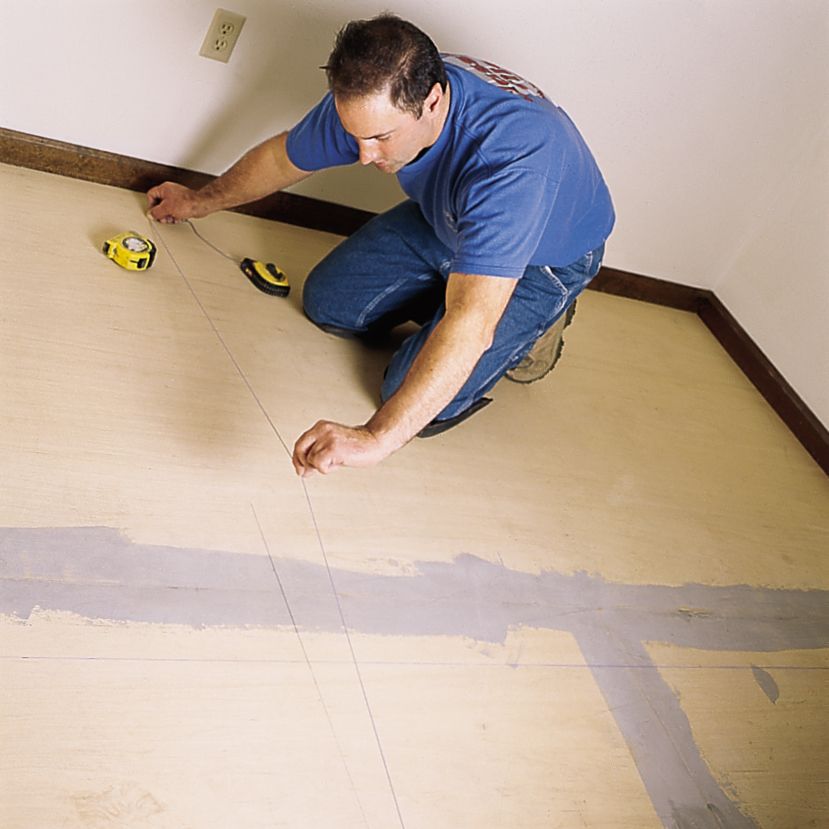
Divide the room into quadrants to achieve a symmetrical and balanced tile layout. Follow these steps to create your quadrants:
- Measure the width of the room in two places, and mark the exact center on the floor in each location.
- Snap a chalk line from wall to wall, and align it with these center marks.
- Measure this chalk line, and mark its center to indicate the room’s center point.
- Use a framing square to create perpendicular lines at the center point, and extend them to the walls.
- Snap a second wall-to-wall chalk line along these perpendicular marks, which will divide the room into four equal quadrants.
- Double-check the alignment of the chalk lines.
Start Tiling at the Room’s Center
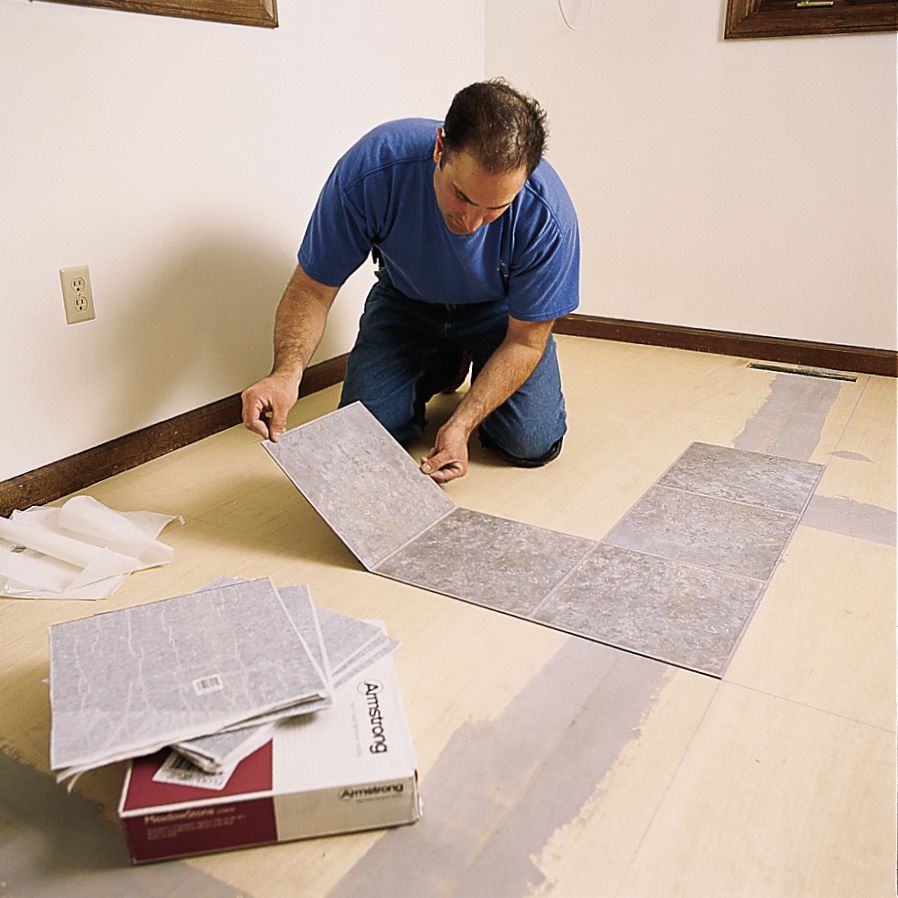
Once you’ve divided your room into quadrants, you can begin laying tiles. Start from the center of the room and work outward to create a balanced layout. Press each tile firmly for proper adhesion. If you’re using glue-down tiles, follow the manufacturer’s instructions for applying adhesive before laying each tile. Follow these steps:
- Thoroughly sweep each quadrant to remove any dust or debris.
- Start at the room’s center point, and begin tiling one quadrant at a time.
- If you’re using self-adhesive tiles, peel off the backing and place the first tile precisely at the intersection of the chalk lines.
- Continue laying tiles in a step pattern. Work outward along the chalk lines and then fill in the spaces between.
- Proceed until you reach the row that’s next to the wall, then move on to the next quadrant.
- Regularly check to make sure you have a straight and even layout.
Scribe Tiles To Fit Along Walls
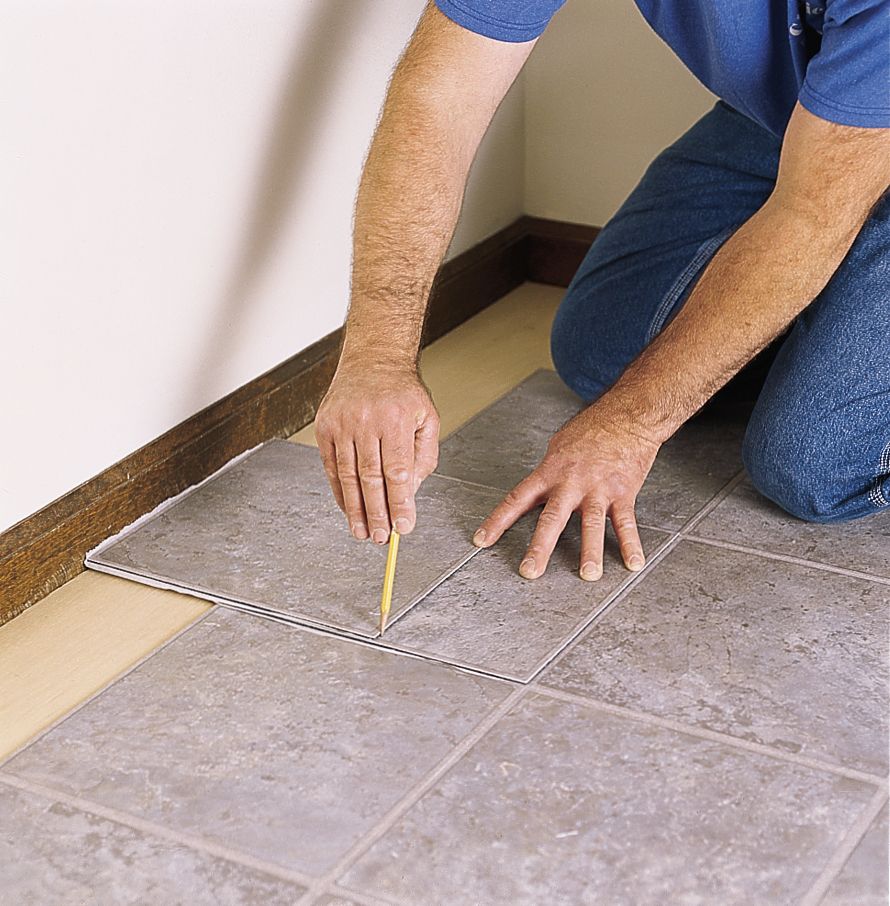
You’ll probably need to cut tiles to fill the space that’s closest to the walls. Here’s how to mark and cut tiles:
- Place a full tile on top of the last full tile that you installed before reaching the wall.
- Take a second tile and position it against the wall so that it overlaps the first tile.
- Use a pencil to mark the tile beneath by drawing a line along the inner edge of the top tile.
- Remove the tile you’ve just marked for cutting.
- Make sure the scribed line is accurate before proceeding with the cut.
Cut Tiles to Size

Use a vinyl tile cutter to cut tiles cleanly and precisely. Here’s how to use one:
- Rent or purchase a vinyl tile cutter.
- Lift the cutter’s handle to raise the hardened steel blade.
- Place the marked tile under the blade, and align it with your cutting line.
- Press down firmly on the handle to slice through the tile cleanly.
- Carefully check the cut for accuracy before proceeding.
Follow the steps below if you need to work your way around obstacles or achieve other complex cuts:
- Use a heat gun to soften tiles slightly.
- Carefully cut along your marked lines using a sharp utility knife.
- Make multiple passes with light pressure rather than trying to cut through in one fell swoop.
Always wear safety glasses and work gloves when cutting tiles to protect yourself from sharp edges and debris.
Trim Tiles Around Heat Registers
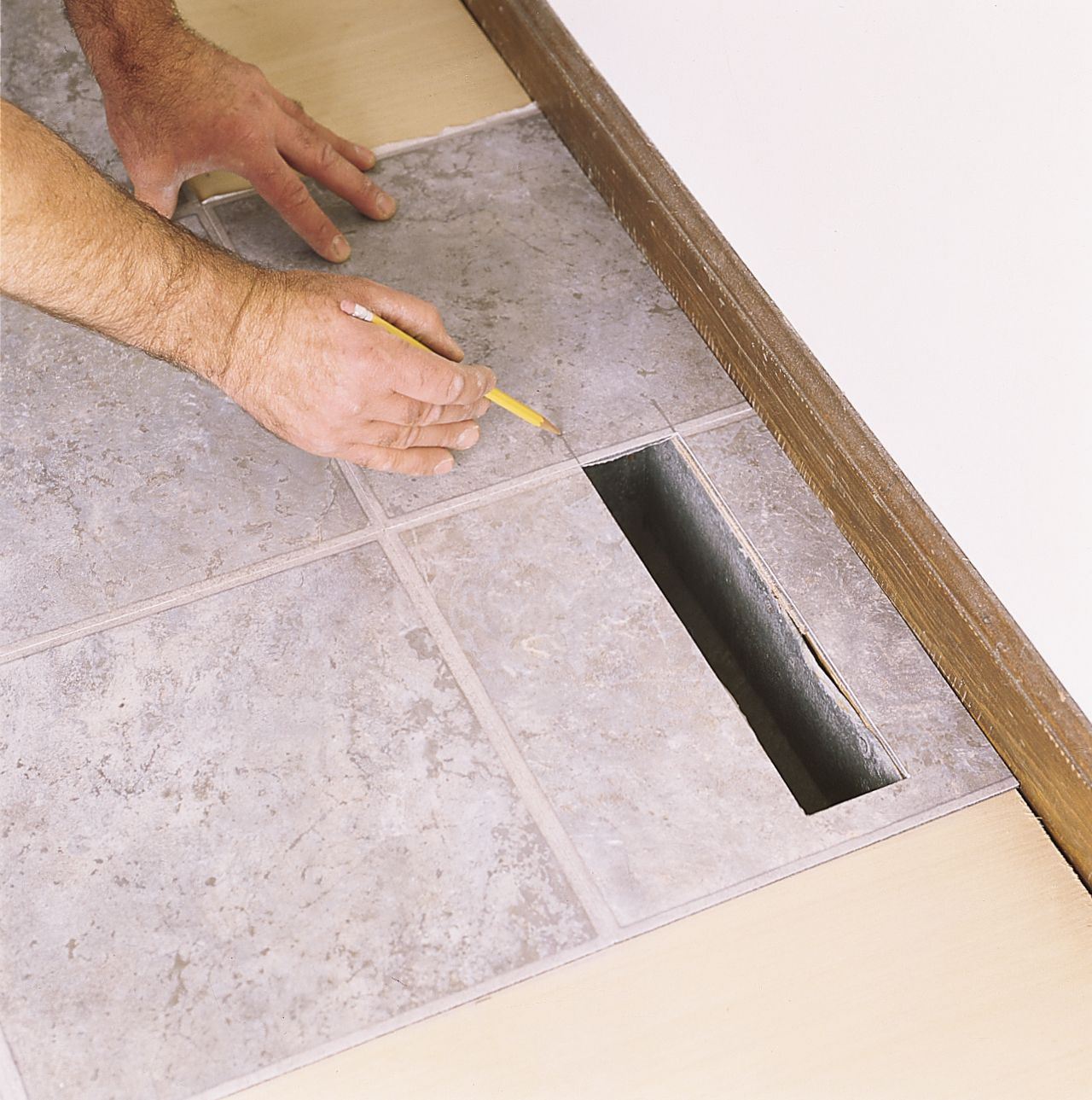
Follow the steps below to fit tiles around heat registers, which requires precision:
- Remove the grille from the heat register to expose the rectangular opening.
- Place a full tile over the opening, and press it against the wall.
- Use a pencil to mark the spots at which tile overlaps the duct opening.
- Remove the tile and use a heat gun to soften it slightly.
- Use a utility knife to carefully cut along your marked lines.
- Test-fit the cut tile before removing the backing paper and setting it.
- Reinsert the grille to check the fit and make any necessary adjustments.
Install Shoe Molding
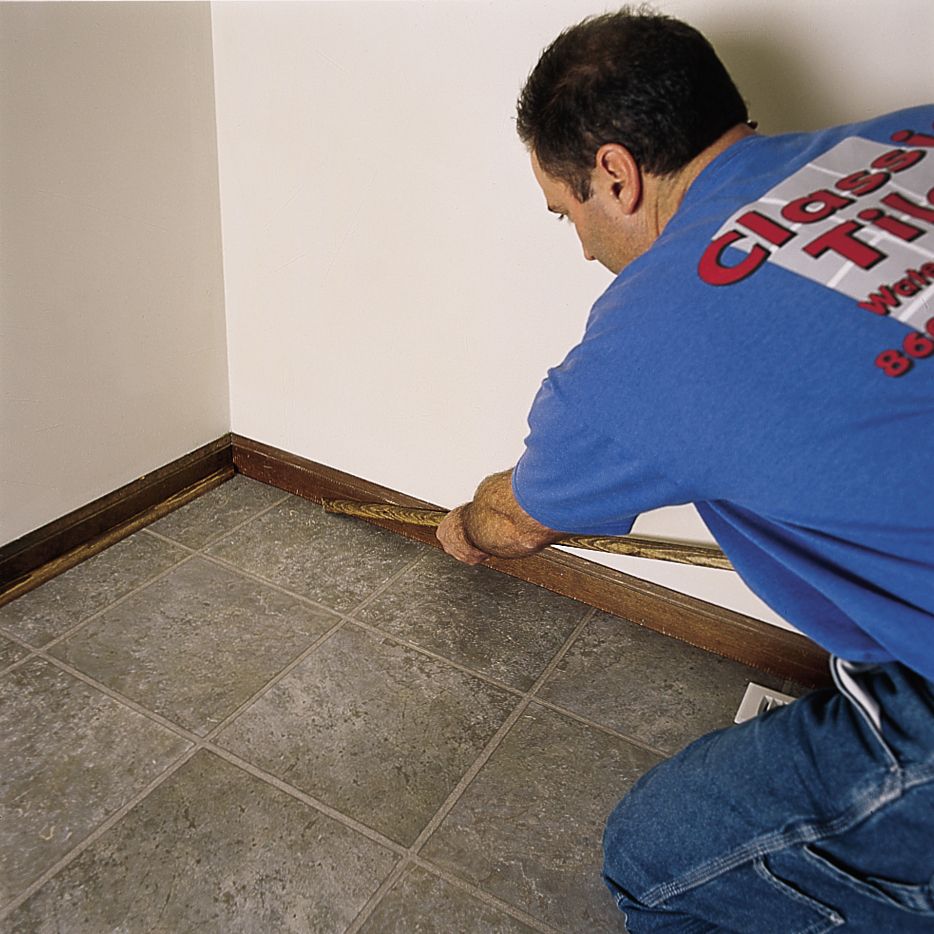
Complete your tile installation by installing shoe molding to cover the expansion gap between the tiles and the baseboards. This amounts to a finished look and allows for slight movement of the floor. Follow the steps below.
- After you’ve placed all of your tiles, use a baker’s rolling pin or a J-roller to make sure tiles have firmly bonded to the underlayment.
- Measure and cut shoe molding so that it fits along the walls.
- Nail the shoe molding in place using 1 1/2-inch finishing nails.
- Use wood filler to cover nail holes, and paint the molding to match your baseboards.
- Clean the new floor thoroughly to remove any dust or adhesive residue.
Wait at least five days before washing the floor to allow the adhesive to fully cure.











